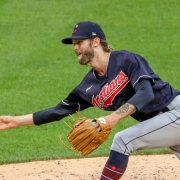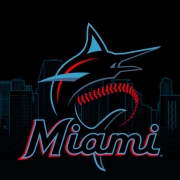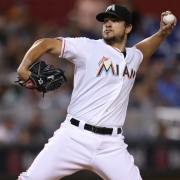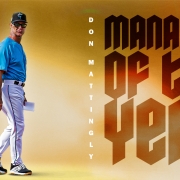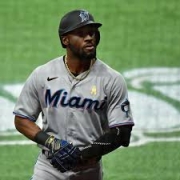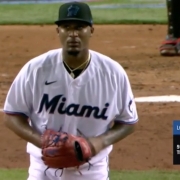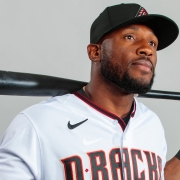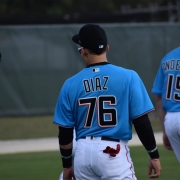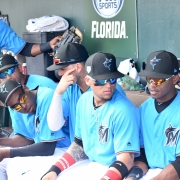It’s no surprise coming off an incredible 60-game season which saw the Marlins make their first postseason appearance in 17 years (and win a playoff series at that) amid a COVID-19 outbreak which ravaged the roster three games into the season that Jeter and Co. are looking to build upon their 2020 success. This starts when the Marlins turn to the free agent market.
This process really began with the monumental hiring of Kim Ng as the team’s next general manager, marking the first time that a woman had been named GM of any North American professional sports team. Further, it is the first time that a Asian-American has held the role, breaking a barrier that had stunted the success of women and minorities in sports while giving new hope and inspiration to girls from all different ethnicities and walks of life interested in a high-level career in sports.
This, however, does not mark the end of the offseason for the Fish. It’s only the beginning. With a seemingly minuscule payroll relative to the rest of the league at $46 million and an ownership group which has made it clear that they’re willing to spend appropriately, there are several aspects of the Major League roster that could be improved upon via free agent additions to make the club even better heading into the 2021 season.
Today, we’ll take a look at the top five free agent targets for the Marlins this offseason.
Marlins Free Agent Target No. 5: Michael Brantley, OF/DH
The Fish’s depth chart in the outfield is, crowded, to say the least. Despite this, the team had a combined bWAR of 0.4 in the outfield in 2020, due to struggles from rookie Monte Harrison and a lack of production from veteran left fielder Corey Dickerson. Though the Marlins have many prospects on the horizon awaiting their ability to contribute at the highest level and impact player Starling Marte manning center, the Fish still lack a consistent, everyday hitter. Enter: Michael Brantley.
Brantley has swung the bat well everywhere he’s been. He posts a career 116 OPS-plus while bringing solid power numbers and a high average to the table. Unlike Dickerson, Brantley is an above-average left fielder. He had one of the highest DRS (defensive-runs-saved) totals of any left-fielder in the truncated 2020 season with five. Adding a professional bat into the lineup who wouldn’t be a liability in the outfield while providing DH flexibility (assuming the DH stays in the National League in 2021) could provide the Marlins a substantially better offense.
Drawbacks to Adding Brantley
However, there are several downsides to this signing. As stated, the Marlins have MANY outfield options. Dickerson, Lewis Brinson, Harrison, Jesus Sanchez, Magneuris Sierra, and JJ Bleday are all assured or competing for a spot. If Brantley is signed with the intentions of him DH’ing, what does that mean for Garrett Cooper or Jesus Aguilar?
With Aguilar coming off a resurgent year and Cooper cementing himself as a legitimate threat in the lineup, only one of the two can play first base at a time. That leaves the other on the bench if Brantley is the DH. This wouldn’t bode well for the Marlins, as they could see a drop off in production in the two if they were not playing every day, which they should be. The two combined were 25 percent better than the average major league hitter (a .125 OPS-plus).
My conclusion is this. With the logjam of outfielders and lack of a spot for him, the Fish shouldn’t consider talks with Brantley. That is, unless one or multiple pieces at either first base or outfield are moved to make room for him. If this occurs, then the enticing upside of the left-fielder may reel Ng and Jeter into pushing for a deal.
Free Agent Target No. 4 Tommy La Stella, 2B
After the departure of Starlin Castro via free agency in the 2019 offseason, it was all but given that former top prospect Isan Diaz would run away with the starting second base role. However, a pandemic halted any of these talks. Diaz, who had presumably won the role during the summer camp ramp-up before the season, made the tough decision to opt-out of 2020 play. He cited concern over the virus for his and his family’s sake.
This led Jonathan Villar (among many others) to play the position when play resumed. Villar was traded to the Blue Jays at the trade deadline, leading to speculation as to who would man the spot. Soon thereafter, Isan opted back into the season to play the remainder of the year with the Fish. As exciting as this was, it did not provide many results. He slashed .182/.182/.182 in seven games before going out with a groin injury, ending his season.
Top prospect Jazz Chisholm split time with utility man Jon Berti after this, though it’s possible Jazz was rushed to the bigs, as he posted a .161/.242/.321 slash line in his cup of coffee.
Adding La Stella
This lack of production, aside from Berti, who has provided consistent offense, speed, and defense during his tenure, though does not fit into the Marlins’ future plans at age 30, leads to questions about Diaz and Chisholm’s actual readiness for the big leagues, and raises questions as to whether or not the duo should start 2021 with the team’s Triple-A affiliate. If this is in Ng’s plans, she may seek a stopgap at the position, whether to split time with Berti or to play there every day. This stopgap could be Tommy La Stella.
La Stella would be a nice fit in Miami as a left-handed infielder with positional flexibility and consistent contact. (27 walks to only 12 strikeouts in 2020.) He improved his power numbers (slugging percentage of .486 and .449 in 2019 and 2020 compared to .331 in 2018). La Stella could either split time with Berti (La Stella is a .303 hitter vs righties compared to a .216 one vs lefties). Or play there every day until Isan or Jazz proves they’re ready for the highest level. At that point, La Stella could be flipped for more prospect depth at the deadline.
Potential Negatives to La Stella
A negative facet to this signing is similar to that of the proposed Brantley one, heavy depth at the position. With unofficial captain Miguel Rojas holding down the fort at shortstop in 2021, Chisholm and Diaz are both competing for the job at second. This leads to a possibility that one or the other show they are ultimately ready for the position during spring training. Even 21-year-old Jose Devers could be in the mix. He was added to the team’s taxi squad during their postseason run despite never playing above class A-advanced in the minors.
This leaves La Stella in a tough spot if he is signed. He can’t play third because of Brian Anderson. First base remains loaded with major league depth, and second may not garner much playing time either. Not even a DH role would be guaranteed. Inking La Stella to a deal is useless if he doesn’t play every day.
With a contract I expect will demand upwards of $7-million, signing La Stella to a one-year deal would speak lengths as to where the organization feels Isan and Jazz are. He would most likely be their placeholder until one is ready. Otherwise, a diminished role is a moot utilization of the 31-year-old veteran.
Marlins Free Agent Taget No. 3: James McCann, C
Perhaps the most important position to address, the Marlins did not see much production at all from two of their top three catchers in 2020. Aside from Francisco Cervelli (who has retired), the Marlins’ two other catchers on the roster from Opening Day on were not very valuable behind the dish.
Jorge Alfaro, the team’s immediate catcher of the future after trading J.T. Realmuto to the Phillies in 2019, has seemed to regress from his time with his old team. A gaudy K rate of 33.1 percent in 2019 was somehow topped this year in 2020, as Jorge K’d 36 percent of the time this past season (36 strikeouts in 100 at-bats). He provided a negative dWAR all the while. His struggles on both sides of the ball warranted his benching during the postseason. Backup catcher Chad Wallach, who slashed .227/.277/.364 in the regular season, started over him. Manager Don Mattingly cited defense as the reason.
This tandem posted a combined -0.4 WAR in 2020. And though Alfaro was infected by COVID-19 and never got into a groove, this lack of impact behind the plate cannot be perpetuated if the Marlins want to contend in 2021. Especially with little catching depth at the minor league level.
Upgrading at Catcher a Must
This leads to the possibility of the Fish signing former Tiger and White Sox catcher James McCann. It would be a GREAT signing at that. The 30-year-old has been one of the most consistent backstops over the last two seasons, posting a solid 4.0 oWAR and 126 OPS-plus in that time frame. And that isn’t all.
He has been VERY valuable behind the plate. He registered a nine DRS and a 32 percent caught-stealing-rate since 2019, whilst ranking in the top 11 percent in framing in 2020 (per Baseball Savant). Alfaro ranked in the 34th percentile in said metric in 2019 (not enough data to track this season). Meaning, McCann was able to steal strikes for his pitchers a lot more effectively than Alfaro.
Signing McCann would allow for Miami’s young starting pitching core to build a better rapport and trust with him. And they would in turn be more successful due to the intangibles and experience McCann has that Alfaro unfortunately lacks.
Final Thoughts on McCann
McCann’s dWAR the past two seasons alone (1.7) is more than Alfaro and Wallach’s total WAR combined in that time (1.1).
The only qualm with signing him is the money he may command. The highest AAV on the books belongs to Starling Marte at $12.4 million over one-year. Though ownership cited a willingness to spend, it’s possible McCann could seek an AAV upwards of $15 million over several years, a financial commitment I’m not sure the Fish are willing to make.
Furthermore, if McCann is signed and deemed the catcher for the foreseeable future, where does that leave Alfaro? Undoubtedly talented with a rare combination of power and speed for a catcher, his role as a backup at age 27 could stunt any further player growth and even diminish his confidence. This could lead to the possibility that he’d be traded if McCann were inked to a deal in Miami.
Closing thoughts? McCann in caliente red makes all the sense as the position lacks production offensively and defensively with the current options. But the looming inevitability of a big payday and the inquiries surrounding current starter Jorge Alfaro’s role lead to many questions as to the legitimacy of a deal materializing
Free Agent Target No. 2: Alex Colome, RHP
The most obvious allocation of 2021 free agent money should be towards the Marlins’ bullpen. With some of their biggest 2020 contributors in Brad Boxberger and Brandon Kintzler becoming free agents, the Fish should aim to resign those two. Yimi Garcia, signed in the 2019 offseason, dazzled in 2020. And he looks to be a key setup man moving forward. However, there isn’t much certainty after that.
Right-hander Jamey Hoyt was effective with a 1.23 ERA this past season. But the 34-year-old was in the bottom eight percent in exit velocity per Baseball Savant. He threw his slider 67 percent of the time, leading to regression and predictability concerns.
Jose Urena, the longest-tenured member of the organization currently, had a rough 2020 amid a bout with COVID and a season-ending forearm fracture. He finished with a 5.40 ERA and 6.06 FIP. Other bullpen arms weren’t too reliable, either. This includes Ryne Stanek (diminished velocity and pitch effectiveness), Stephen Tarpley (BB/9 of 6 with average stuff), Robert Dugger and Nick Neidert (unproven rookies who struggled with COVID), and Jordan Yamamoto (let’s not talk about it).
Signing Colome Helps the Bullpen
If nothing else, signing Alex Colome would make that heads or tails bullpen a bit less worrisome. The Dominican right-hander logged 22 and a third sparkling innings for the White Sox in 2020. He pitched to a 0.81 ERA combined with a 2.97 FIP, ensuring that his success wasn’t influenced by good luck. The numbers back this up. He was above average in exit velocity, xSLG (expected slugging percentage against), and barrel percent (how frequent opposing batters barreled him) percentiles. This means he induced soft contact the entire year and was rarely hit hard.
This bodes well for a Marlins ‘pen that has had many volatile relievers who have had elite stuff but weren’t been able to limit hard contact, and he’d immediately fit into a setup or even closer’s role.
There aren’t many downsides to a signing like this, except for fear of regression due to the fickle nature of relievers in general. It may be noted though that Colome only relies on two pitches: a high-80s cutter and a mid-90s fastball. As long as Colome does not lose velocity on his four-seam fastball, as Kenley Jansen did, all indications point to continued effectiveness from him.
This would be a slam-dunk signing by the Fish. A one-year deal for $12-ish million would fortify a bullpen with high upside but many inconsistent performers. Colome’s track record, veteran experience, and overall ability would make the Marlins even better in 2021.
Marlins Free Agent Target No. 1: Brad Hand, LHP
Nothing more necessarily needs to be said about the Marlins’ bullpen. But for what it’s worth, lefty Richard Bleier cannot be the only southpaw to hold the fort down. Tarpley’s future fit with the team is questionable even right now. Hmmm…if only there were a former Marlin on the free-agent market who became one of the most effective left-handed relievers in the game after departing from the team. Oh wait, there is…BRAD HAND!
Hand has been nothing but rock solid since being DFA’d by the Fish back in 2015. He’s posted a 2.70 ERA and 157 ERA-plus (meaning he has been 57 percent better than the average MLB pitcher) between 2016 and 2020. And racked in an amazing 1.37 FIP in the truncated 2020 season for the Indians.
Hand still has an elite slider, one that moves 7.2 inches more than the average slider. Though he may not have a 95-mph fastball anymore, his low-90s heater plays up due to high spin rates (top 14 percent in fastball spin). He still performs extremely well in expected stats such as xERA (expected ERA), xSLG, and xBA (expected opponent batting average), leading to the low FIP.
Will Hand Accept a Pay Cut?
Barring an unwillingness to pay Hand a probable salary of $10-$14 million, he should fit in amazingly with Bleier. The two could form one of the best southpaw duos in the sport. One would contributed as a late relief option and the other projecting as the dominant closer they’ve vied for for ages.
Whether the Fish sign one, two, multiple, all, or none of these guys, the 2021 Miami Marlins offseason is set to be filled with tons of hype and excitement for hopefully a much better 162-game product than we’ve seen in a long time.

